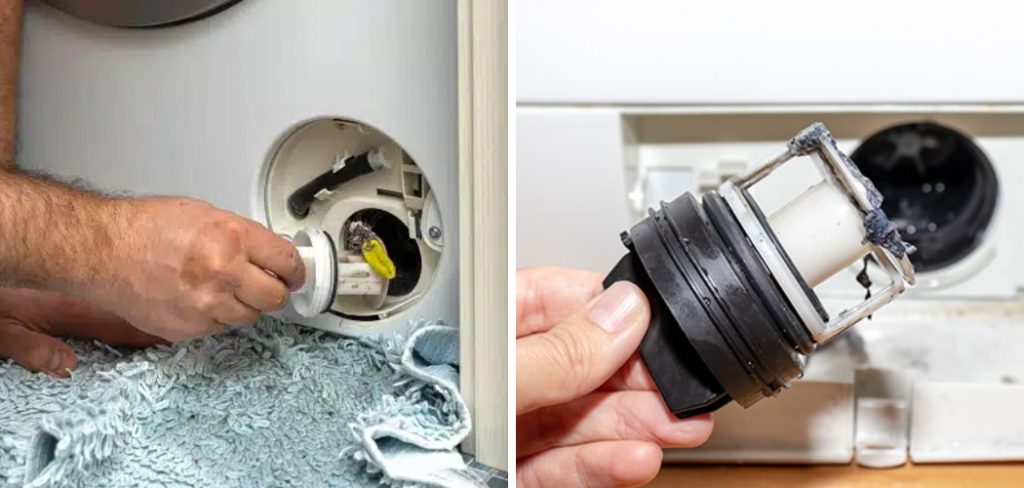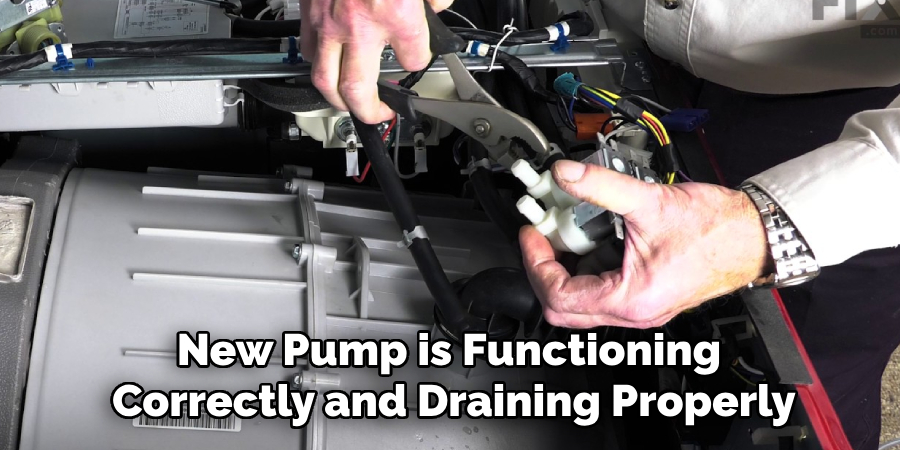A properly draining washer is essential for maintaining laundry efficiency and ensuring that clothes are thoroughly cleaned and free of water. Without proper drainage, an LG washer can leave clothes soaking wet, leading to longer drying times and potential mold or mildew buildup. Common symptoms of an LG washer not draining include standing water in the drum, specific error codes on the display, and unusual noises during the draining phase.

This guide provides a step-by-step approach on how to fix lg washer not draining, making it easier for homeowners to identify and resolve the issue. By following this comprehensive troubleshooting guide, you can diagnose the problem, gather the necessary tools and materials, and execute the required repairs effectively. Whether clearing blockages from the drain hose or replacing a faulty drain pump, this guide covers all aspects to ensure your washer operates smoothly again.
Diagnosing the Problem
Identifying the signs of a washer not draining is the first crucial step in troubleshooting. Some common indicators include standing water inside the drum after a wash cycle, error codes such as OE displayed on the control panel, and unusual noises like humming or gurgling during the draining phase. To pinpoint the issue, check for any blockages or obstructions in the drain hose; kinks or clogs can prevent water from escaping.
Next, inspect the drain pump to ensure it’s free of debris. Factors such as lint buildup, small clothing items, or other foreign objects could be causing a blockage. Clogged filters or faulty components within the washer can also be culprits. By thoroughly assessing these elements, you can determine the root cause of the drainage problem and move towards an effective solution.
Tools and Materials Needed
You will need a set of essential tools and materials to effectively troubleshoot and repair an LG washer that is not draining. The basic tools required include a screwdriver, pliers, a bucket to catch water, and some towels to clean up any spills. Necessary materials encompass cleaning supplies to clear blockages and replacement parts such as a new drain pump or drain hose if needed. Optional items that can make the task easier are a flashlight for better visibility in tight areas and a drain snake to help remove stubborn clogs from the hoses and pump.
How to Fix Lg Washer Not Draining: Troubleshooting Steps
Safety Precautions
Before beginning any troubleshooting steps on how to fix an LG washer not draining, it is paramount to ensure your safety. Start by unplugging the washer from the electrical outlet to eliminate the risk of electric shock during repairs. Handling water in or around electrical appliances can be especially dangerous, so taking this precaution for your own protection is essential. Additionally, water drainage must be managed with care to avoid spills and mess. Place towels or a bucket nearby to catch any residual water that may escape.
This will help maintain a clean workspace and prevent any potential slips or falls. Always work in a well-ventilated area with ample lighting to ensure you can clearly see what you are doing. By following these safety precautions, you can troubleshoot in a secure environment, minimizing the risk of injury and property damage.

Checking the Drain Hose
One of the common causes of a washer not draining is an issue with the drain hose. Start by inspecting the drain hose for any visible kinks, twists, or clogs that could be obstructing water flow. Straighten out any bends and look closely for any blockages. You can use a drain snake or a cleaning brush to remove any debris or sediment built up inside the hose. Ensure that you run the snake or brush through the entire length of the hose to effectively clear out any obstructions.
Once cleaned, verify that the hose is properly connected to both the drain and the washer. A loose connection could also contribute to drainage issues. If the hose is worn or damaged, consider replacing it with a new one to ensure optimal performance. You can significantly improve the washer’s drainage efficiency by thoroughly checking and maintaining the drain hose.
Examining the Drain Pump
After addressing potential issues with the drain hose, the next step in troubleshooting is examining the drain pump. Most LG washers have a drain pump filter access panel on the appliance’s front lower section. Open this panel carefully to access the drain pump. Inspect the pump for any debris, such as lint, small clothing items, or other foreign objects that may be blocking the water flow. Removing these obstructions will help restore proper drainage.
Use a cleaning brush or rag to clean the pump thoroughly. Once cleared, manually spin the pump impeller to check for smooth operation. A stuck or stiff impeller can indicate a malfunctioning pump, which may need to be replaced. Ensuring the pump is free of blockages and in good working condition is crucial for draining the washer effectively. Regular maintenance and cleaning of the drain pump can prevent future drainage problems and extend the life of your appliance.

Testing and Repairing Components
Ensuring that each component of your LG washer is functioning correctly is crucial for solving drainage issues. By systematically testing and, if necessary, repairing the drain pump, you can get your appliance back to optimal performance.
Testing the Drain Pump
Begin by manually spinning the pump impeller to check for smooth operation. If the impeller feels stiff or stuck, this could indicate a problem with the pump that requires attention. Next, a multimeter tests the pump motor to ensure it receives power. Set the multimeter to the voltage setting and carefully measure across the pump terminals while the washer is in a drain cycle. If the multimeter does not show a voltage reading, the pump motor may not be receiving power or the motor itself could be faulty. Any inconsistency here may require a more thorough inspection or repair.
Replacing the Drain Pump
If the drain pump is determined to be damaged or malfunctioning, it’s necessary to replace it. Start by disconnecting the washer from the power source and accessing the drain pump through the access panel. Carefully remove the old pump by disconnecting any electrical connectors and loosening the mounting screws. Place the new drain pump into position, securing it with screws and reconnecting the electrical connectors. Finally, reassemble any removed panels and plug the washer back in. Test the washer by running a drain cycle to ensure that the new pump is functioning correctly and draining properly.

Common Issues and Solutions
Clogged Filters
Clogged filters in the drain pump assembly are a frequent culprit behind drainage issues in LG washers. To clean or replace the filters, start by locating the drain pump filter access panel and opening it. Carefully remove the filter and clean off any debris, lint, or small objects that may be obstructing water flow. If the filter appears damaged or excessively worn, replace it with a new one. To prevent future clogging issues, routinely check and clean the filters. Regular maintenance can help ensure proper water flow and extend the lifespan of your washer.
Faulty Drain Pump or Motor
A faulty drain pump or motor can also lead to drainage problems in your LG washer. Inspect the drain pump and motor for visible wear or damage, such as cracks, corrosion, or broken components. Use a multimeter to test the pump motor to ensure it receives adequate power and functions correctly. If the tests indicate that the pump or motor is faulty, it must be replaced. Disconnect the washer from the power source, remove the damaged part, and install a new drain pump or motor, securing all connections and components before testing the washer.
Testing and Maintenance Tips
After completing any repairs on your LG washer, it is essential to run a diagnostic cycle to ensure that the drainage issues have been fully resolved. This cycle will help you verify that the water drains properly and that all components function as intended. Regular maintenance is crucial for the long-term performance of your washer. Make a habit of cleaning the filters periodically to prevent clogging and blockage. Additionally, routinely inspect the drain hose for any signs of wear and ensure it remains free from kinks and blockages.

Keep an eye on your washer’s performance, paying attention to any signs of recurring drainage issues, such as unusual noises, prolonged draining times, or water remaining in the drum. Addressing these issues early can prevent them from escalating into more significant problems, ensuring your washer operates efficiently and reliably.
Conclusion
In summary, troubleshooting an LG washer that is not draining involves several key steps. Begin by checking the drain hose for clogs, kinks, and signs of wear, and replace it if necessary. Next, examine and clean the drain pump and its filter, removing any debris that might obstruct water flow. If further issues persist, test the drain pump’s functionality and consider replacing it if it is found to be faulty.
Regular maintenance, such as cleaning filters and ensuring hoses are free from blockages, is essential for the efficient operation of your washer. These preventive measures can significantly extend the lifespan of your appliance. Do not hesitate to seek professional assistance for complicated repairs or persistent issues. Knowing “how to fix lg washer not draining” can save time and prevent more severe problems, but expert help ensures that your washer remains in optimal condition.
